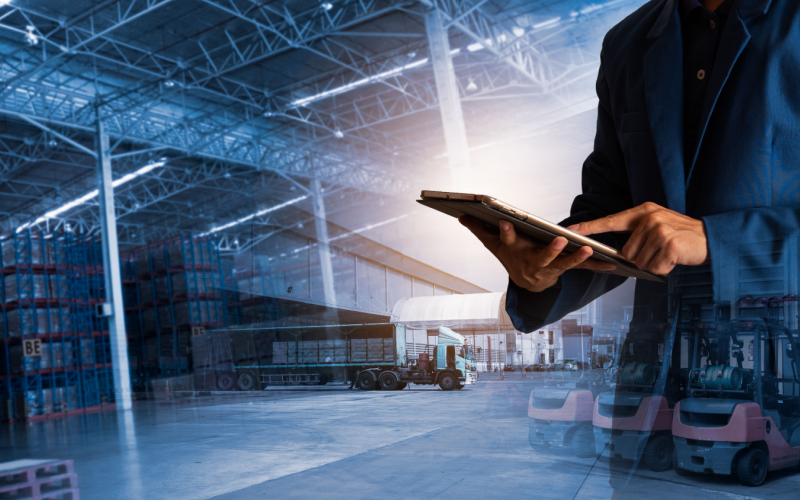How 3PL and 4PL Stay Ahead of the Business and Technology Curve, Part 1
In a series of blog articles, the Product/Solutions Marketing team explores new business challenges and innovation solutions to change the game and manage disruptions. The following are the insights gained from my discussion with Ann Marie Jonkman, who leads Blue Yonder’s 3PL Industry Strategy, and the logistics events that we prepared for.
Key Imperatives
Terence: The logistics industry is going through digital transformations and business model changes. 3PLs, 4PLs and distributors are looking for solutions to manage omni-channel, as well as improve profitability. Because of these key imperatives, the logistic industry is undergoing so many changes. Can you summarize the key trends you are seeing?
Ann Marie: I think you hit the nail on the head with the term transformation. It is an area of opportunity where businesses are looking at their end-to-end processes and systems. We are looking at opportunities to help our customers reduce cost, automate tasks, improve sustainability and improve their labor positioning, whether this is an automation play or a labor play. The desired result is that the end customer experience will be superior and improved.
Key Initiatives for Operational Improvements
Terence: What are the key initiatives for operational improvements?
Ann Marie: There are quite a few initiatives in the digital transformation journey. For example, our customers are looking at:
- Automation of processes and tasks.
- Sustainability and how labor can be more optimally leveraged.
- Agility (as opposed to being reactive) in terms of inventory placement and last mile.
- Inventory placement and the robust expansion of micro-fulfillment centers, which are important now and will be even more important in the future.
- How to leverage data to ensure they can meet their customers where they are at today and that inventory is placed at the most optimal location from a distribution network perspective. They have always had data for their businesses and their online customers, but they are tapping into artificial intelligence (AI) and machine learning (ML) to leverage the opportunity to get ahead of the herd.
- Capacity optimization, such as for space for warehousing, e-commerce and retail, is still congested, especially in the markets where there is heavy competition. Warehouse space is at a premium, so companies are looking at optimizing capacity with a partner and locking down the space for in-demand products.
Terence: What are the transformation initiatives mainly designed for?
Ann Marie: For many companies, they would like to minimize the negative impact from disruptions instead of having to make expensive changes when they are in the middle of disruptions and provide reactive plans to their board.
Plan of Attack for Labor Challenges
Terence: Please share insights on how companies can tackle labor challenges.
Ann Marie: There has been an evolution in how companies view the labor challenge the past few years. Companies are looking at their end-to-end processes and at their technology partners to help them solve for this challenge. It is super important right now for logistics executives and operations to make sure:
- Labor is optimized and aligned with spikes and demand needs.
- Advanced forecasts and promotion models are tightened up for distribution centers, so that there are no surprises on POs and orders.
- Labor and driver models are planned out with back-up plans that have already been communicated.
- Distribution center slotting plans are in sync.
For the next 18 to 24 months, they are looking into:
- Whether the company has an automation play to areas that make sense and how to get the plans for co-bots, pick arms, and center of excellence in place so that labor is further optimized.
- Being an employer of choice by offering flexibility to their staff. Do not be afraid to pull work forward, optimize routes, and use creative partnerships to complete the end-to-end needs.
- A path to eliminate excess waste and achieve optimal safety stock level while ensuring SLAs are meeting customer expectations.
Terence: Are companies looking at how to improve their technologies?
Ann Marie: 3PL and 4PL customers are looking at solution partners such as Blue Yonder for labor, warehouse, transportation, and adaptive micro-fulfillment capabilities. How can the warehouse operations improve and optimize tasking? How can customer service and cost-to-serve in transportation be further optimized? How can they set up micro-fulfillment centers quickly and operate the processes more efficiently? Our transformation advisory teams are here to help map out plans that will meet the new business objectives.
Customer Service as the Key Topic
Terence: With economic uncertainties, what topics are seeing increasing importance?
Ann Marie: It is all about customer service. Anything that can improve customer service is being looked into, in warehouse and transportation management. Can the company hit or exceed its service levels and KPIs? Are there ways to get ahead of disruptions, so that the operations can align the labor and the volume to meet the needs with high service levels? But there is another emphasis: in this changing environment, what can the company do to improve EBITDA?
To move forward quickly, the play over the next six to 10 or 12 months may be a little bit different than the long-term technology vision for 18 to 24 months. As things are changing dramatically, we are here to help companies add concrete value to their supply chains.
Learn More
Visit this webpage about our First-to-Last-Mile Optimization solutions. Come find us at ProMat 2023 in Chicago, we are at Booth #S3380. Learn more from the Unified Logistics and Omni-Channel Execution e-book.
More Insights to Come
In an upcoming Part 2 article, we will get more insights from Ann Marie about sustainability and other important initiatives 3PL and 4PL companies will be taking on in the next 1 to 3 years.

